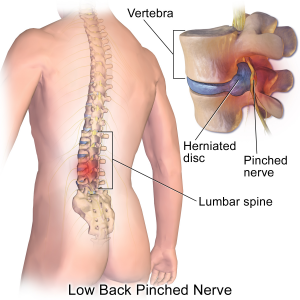
You may have heard the term herniated disc. This can occur anywhere along the spine where a disc is present however most commonly in the lower back and neck. What does that mean you may ask? Technically it means that the nucleus pulposus is not contained within the disc. Still not following? Don’t worry I’ll explain.
So imagine that your disc is like jelly filled donut. You have the outer breading of the donut which is symbolic to what is called the annulus fibrosus of the disc. Then you have the jelly of the donut which is the nucleus pulposus of the disc. A normal healthy disc is the same as a “non-oozing”jelly donut with everyday movements of the human body. When the jelly starts to “ozze” is when the trouble starts.
Herniated disc aka “oozing donut” comes in different shapes and size hypothetically speaking. Depending on how much is “ozzing” is presents correlates with the severity of the symptoms.
For more information on the different types of disc herniations and the anatomy of intervertebral disc, click here- coming soon.
Just on more thing before reading on. Depending on the medical professional, they use bulging, herniated, slipped, etc interchangeably so be aware. Not to say one person is correct or incorrect but the terms use in this website pertains to the actual anatomical changes within the disc.
Causes
If you are a male over the age of 45 you are at more risk of experiencing this condition, just the nature of the beast.
Science has provided significant evidence that poor posture while lifting 20 kg is most common cause of this condition. Other causes may include trauma such as sport related injuries or falls, poor posture over prolonged period of time and sneezing (although I have yet to treat someone due to this.)
Possible symptoms include unilateral or bilateral low back aches and pain, radiating pain down the leg if the disc displaced to a point where it contacts a nerve root with numbness, tingling or muscle weakness.
Treatment
The treatment of herniated disc is more complicated in my opinion than other low back issues because it all depends on which direction the disc is displaced depicting the exercise motions to focus on, the anatomical structures of the disc is compromised and if there is nerve root compression involved. Click here to visually see the different types of disc herniations- coming soon.
Let me try to clarify because this can get confusing.
First thing as I mentioned is figuring out which direction the disc is displaced. Once the mystery of the direction of disc displacement is solved then there are exercises and movement patterns that compliments.
Link- coming soon, a chart to follow step by step in effort to figure out the direction of the herniation. Remember this is a screening tool. For precise answer best to seek a physical therapy or MRI.
Once you have completed the diagram here is a link to the movement patterns that correspond. PLEASE NOTE THAT NONE OF THE EXERCISES ARE TO INCREASE YOUR PAIN SO IF IT DOES PLEASE STOP!
Second, core stabilization exercises along with leg and hip strengthening exercises.
Last but not least, postural education and tips to follow to limit everyday movements that are contributing to the irritation of the disc and or nerves. Click here for tips on how to improve your posture and what to avoid- coming soon.